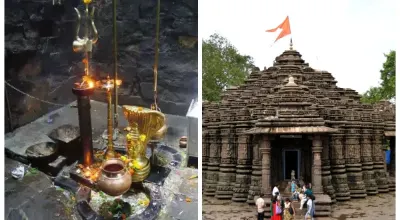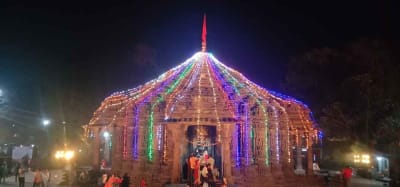Ambarnath shiv mandir
Ambarnath Shiv Mandir
Welcome to Ambarnath Shiv Mandir, a revered Hindu temple situated in the town of Ambarnath in Maharashtra, India. Dedicated to Lord Shiva, this ancient temple is renowned for its historical significance and architectural splendor. Dating back to the 11th century, the temple's intricate carvings, majestic shikhara, and serene surroundings create a mesmerizing aura of spirituality.
History

While the exact date of construction remains debated, most historical accounts place its origins around the mid-11th century, between 1050 and 1060 AD. Here's a glimpse into the captivating history of this architectural wonder:
- The temple's construction is attributed to the Shilahara dynasty, a powerful Marathi clan that ruled parts of western India during the medieval period. Historical records suggest that either King Chhittaraja or his son, Mummuni, commissioned the temple's construction, showcasing their devotion to Lord Shiva.
- Local legends surround the temple, adding to its mystique. One popular story suggests that the Pandavas, the five virtuous brothers from the Hindu epic Mahabharata, built the temple in a single night during their exile. Another legend speaks of a hidden underground passage connecting the temple to nearby areas, although its existence remains unproven.
- Over the centuries, the Ambarnath Shiv Mandir has witnessed various periods of prosperity and neglect. It remained a prominent religious center during the Shilahara rule and subsequent regimes. However, time and neglect took their toll, and the temple's grandeur faded over the years. Thankfully, recent restoration efforts have helped preserve this historical treasure.
Significance

The temple serves as an important center for worshippers of Lord Shiva. The enshrined Shiva linga, a symbolic representation of the deity, attracts devotees from far and wide. They visit the temple to offer prayers, participate in rituals, and seek blessings for peace, prosperity, and spiritual growth. The temple holds special significance during festivals like Mahashivratri, when elaborate celebrations and poojas (prayers) are conducted.
The temple stands as a testament to the architectural brilliance and cultural heritage of the Shilahara dynasty. Built during their reign, the temple reflects the artistic sensibilities and engineering prowess of the era. The Hemadpanthi style, with its intricate carvings and black stonework, is a unique example of architectural heritage. The temple complex, including the sanctum, the mandapa, and the open courtyard, offers valuable insights into the temple design of the period.
The popular story of the Pandavas building the temple in one night during their exile adds a layer of cultural significance. This link to the epic Mahabharata resonates with devotees and reinforces the temple's association with religious devotion and perseverance.
Finally, despite the ambiguity surrounding its origins, the Ambarnath Shiv Mandir stands as a symbol of peace and harmony. The temple welcomes devotees from all faiths and backgrounds, fostering a sense of inclusivity. This welcoming atmosphere resonates with visitors seeking spiritual solace and a connection with something larger than themselves.
Architecture

Built in the 11th century, the temple showcases the Hemadpanthi style, a unique architectural tradition associated with the Shilahara dynasty. Let's delve deeper into the key features that define this architectural marvel:
Black Basalt Construction : The most striking aspect of the temple is its use of black basalt, a volcanic rock known for its strength and durability. The entire structure, from the outer walls to the pillars and doorways, is crafted from this dark stone, giving the temple a distinct and imposing appearance.
The Ambarnath Shiv Mandir deviates from the typical South Indian temple layout with towering shikharas (spires). Instead, it features a more compact design with a distinct layout. The core structure comprises a sanctum sanctorum (garbhagriha) - the innermost chamber housing the Shiva linga. Leading to the sanctum is a pillared hall (mandapa) where devotees gather for prayers and rituals. A unique feature of the temple is the open courtyard situated between the mandapa and the sanctum. This design element adds a sense of openness and allows natural light to illuminate the inner sanctum.
Exquisite Cexquisite carvingsarvings - While the exterior might appear simple at first glance, a closer look reveals adorning the black basalt walls. These carvings depict a variety of themes, including geometric patterns, floral motifs, and legends.
The entrance to the temple complex is marked by an impressive gateway constructed fromm black basalt. This structure features decorative carvings and pillars, serving as a symbolic threshold inviting devotees to enter the sacred space of the temple.
Temple Timings & Location
- Temple Open Hours: 8 AM to 9 PM
- Location: Ambarnath Shiv Mandir is located in Ambarnath, a town in the Thane district of Maharashtra, India. The exact address of the temple is Ambarnath Shiv Mandir Road, Ambarnath East, Ambarnath, Maharashtra 421501.
- Google Maps Link for the location.
How to Reach

- By Train: Ambarnath has its own railway station, which is well-connected to Mumbai, Thane, and other major cities in Maharashtra. You can take a train to Ambarnath Railway Station and then either walk or take a rickshaw or taxi to reach Ambarnath Shiv Mandir.
- By Bus: There are regular bus services from nearby cities like Mumbai, Thane, and Kalyan to Ambarnath. You can board a bus to Ambarnath Bus Depot and then either walk or take a rickshaw or taxi to reach the temple.
- By Car: If you are traveling by car from Mumbai or any other nearby city, you can follow the Mumbai-Nashik Highway (NH-3) and then take the Ambarnath-Badlapur Road to reach Ambarnath. The temple is easily accessible by road, and there is ample parking available near the temple premises.
- By Air: The nearest airport to Ambarnath is Chhatrapati Shivaji Maharaj International Airport in Mumbai. From the airport, you can hire a taxi or take a bus to reach Ambarnath. The temple is located at a distance of approximately 45-50 kilometers from the airport.
Nearby Tourist Attractions
- Shiv Mandir Lake: Adjacent to Ambarnath Shiv Mandir is the Shiv Mandir Lake, a serene and picturesque spot ideal for a peaceful stroll or relaxing by the waterside.
- Kondeshwar Temple: Located about 10 kilometers from Ambarnath, Kondeshwar Temple is dedicated to Lord Shiva and is known for its tranquil ambiance and beautiful waterfall nearby.
- Barvi Dam: Situated around 15 kilometers from Ambarnath, Barvi Dam is a scenic spot offering panoramic views of the surrounding hills and a tranquil atmosphere for picnics and nature walks.
- Tansa Lake: Approximately 20 kilometers from Ambarnath, Tansa Lake is a popular destination for boating, fishing, and enjoying the natural beauty of the lake and its surroundings.
- Titwala Ganesh Mandir: About 20 kilometers from Ambarnath, Titwala Ganesh Mandir is a revered temple dedicated to Lord Ganesha, attracting devotees from far and wide.
Plan your Next Trip

As we conclude our journey through the spiritual and scenic wonders of Ambarnath, Maharashtra, we invite you to plan your next trip to ths enchanting town. Whether you seek divine blessings at Ambarnath Shiv Mandir, soak in the tranquility of Shiv Mandir Lake, or explore the natural beauty of nearby attractions like Kondeshwar Temple and Barvi Dam, Ambarnath promises a memorable experience for every traveler.




